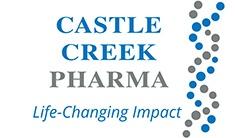Results from evaluation of the Phase 2 study of diacerein 1%
ointment (CCP-020) presented during the Winter Clinical
Dermatology Conference
PARSIPPANY, N.J., Jan. 15, 2018 /PRNewswire/ — Castle Creek Pharmaceuticals (CCP), a global biotech company dedicated to delivering transformative therapies to patients with orphan dermatologic and other underserved conditions, today announced that data from an evaluation of a completed Phase 2 study of diacerein 1% ointment (CCP-020) for the treatment of epidermolysis bullosa simplex (EBS) validate the first disease-specific Investigator's Global Assessment (IGA) scale. Results are being presented at the Winter Clinical Dermatology Conference held January 12-17, 2018 at the Hyatt Regency Maui in Hawaii.
EBS is the most common form of epidermolysis bullosa, a rare dermatologic condition where patients, many of them children, have a genetic defect that compromises the structural integrity of their skin, making it particularly fragile and prone to blistering throughout their bodies. The disease can be severely debilitating and there are no treatment options currently available.
CCP recently announced the development of a novel five-point IGA scale for overall clinical assessment that defines EBS-involved skin as Clear, Near Clear, Mild, Moderate, and Severe based on the presence or absence of blisters and factors including blister size, erosions, crusting and erythema. The previous Phase 2 study of CCP-020 used blister count reduction as the primary efficacy endpoint, due to the absence of an instrument for clinicians evaluating the effects of pharmacological interventions on overall disease severity for people living with EBS.
"Developing therapies for rare skin diseases like EBS comes with certain challenges because there is often limited or no prior clinical research providing disease progression insights that can serve as the foundation for clinical endpoints," said Greg Licholai, MD, president and chief medical officer at CCP. "As we work to support an underserved patient population, we have a responsibility to develop effective protocols that can be applied to current and future clinical studies, and we believe this new IGA scale is a tremendous step forward for EBS research."
To validate the new IGA scale, investigators reviewed blinded photographs of affected body locations obtained from patients at each visit during the Phase 2 study. The primary endpoint was the proportion of patients with moderate-to-severe lesions who achieved treatment success, defined as an IGA score of 0 or 1 on a 5-point scale at week 16 of treatment with at least a 2-point reduction in the IGA score compared to baseline. Additional clinical endpoints included the proportion of patients with a 2-point reduction from baseline to week 16 and the mean decrease in IGA score.
Results showed a significantly higher proportion of moderate-to-severe treated lesions reached Clear or Near Clear status and at least a 2-point reduction from baseline (58% vs 40%; P=.036). The proportion of lesions treated with CCP-020 with only a 2-point reduction in IGA score also trended higher compared to control lesions (70% vs 47%; P=0.067). A greater mean reduction in IGA score from baseline to week 16 was achieved for lesions treated with CCP-020 versus control (2.4 vs 1.7; P=.001).
"A novel disease-specific 5-point IGA scale may be useful to better evaluate new treatments for people living with EBS," said Johann Bauer, MD, MBA, HCM, head of the University Clinic for Dermatology of the SALK/Paracelsus Medical University and the study's principal investigator. "This analysis confirms treatment effects in EBS patients based on published data from the Phase 2 study of CCP-020."
CCP plans to include the IGA scale in the analysis of the overall disease severity in patients with moderate-to-severe EBS in the ongoing Phase 3 DELIVERS study evaluating the safety and efficacy of CCP-020.
Contact
Adam Daley
Berry & Company Public Relations
Tel: +1 212 253 8881
Email: adaley@berrypr.com
SOURCE Castle Creek Pharmaceuticals


